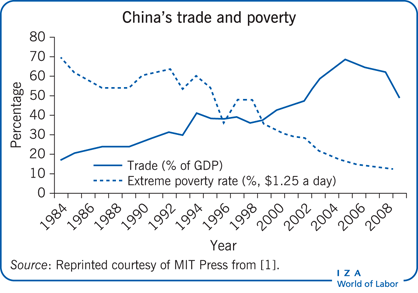Elevator pitch
Economic growth is essential, though not sufficient, for poverty reduction in developing countries. Research based on many different approaches and including both cross-country and intra-country studies shows that international trade can contribute to economic growth, and thus can help many poor people escape poverty. However, the domestic environment has to be conducive to realizing the poverty-reduction benefits of increased trade. Complementary domestic policies and institutions needed include regulations that foster labor mobility, adequate financial development, and good public infrastructure.
Key findings
Pros
Poverty rates fell dramatically in China and India as trade increased.
Some evidence of trade’s effect on poverty comes from recent cross-country analysis that includes a very large set of developing countries.
Most intra-country studies also find that trade reduces poverty.
Trade increases incomes, and economic growth reduces poverty.
“Appropriate” policies complementary to trade reforms include: product diversification, suitable agricultural policies, and policies promoting financial development, protecting property rights, and developing vital infrastructure.
Cons
There is no confirmation of causality in the China and India case studies on trade and poverty reduction.
Cross-country regression results linking trade and poverty reduction lose their significance when time effects are taken into account.
Analyses at the district level in India lead to results that are inconsistent with the recent findings of a positive relationship between trade and poverty reduction at the cross-national level.
Few studies on the trade-poverty relationship have looked at the interactions with appropriate complementary domestic policies and institutions.
